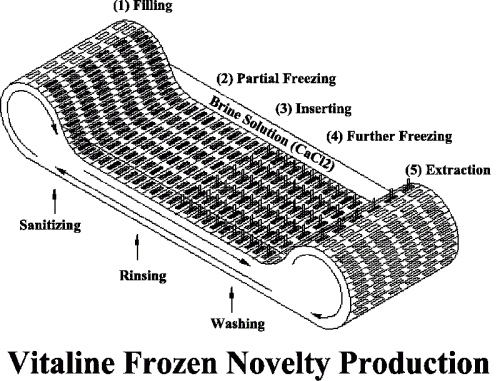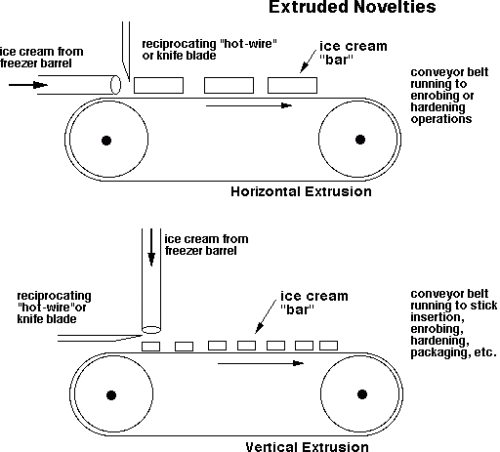Ice Cream Manufacture
9 Ice Cream Novelty/Impulse Products
Molded Novelties
Ice cream novelties are typically single-serving items bought from vendors for immediate consumption. They come in a variety of shapes, sizes, colours, flavours, etc., and manufacturers are constantly developing new items to compete for market share. Hence, this category is variably known as either impulse products or novelty products. These products can be manufactured by a number of processes.
Products such as popsicles or ice cream with flat sides on sticks are manufactured by filling a mold with water ice or soft ice cream from a barrel freezer, immersion freezing that mold in a cold bath of calcium chloride solution, inserting the stick when partially hardened, and then after hardening is complete, removal of the ice cream from the mold by the stick.
Point 1 = filling;
Point 2 = partial freezing as the molds progress in the calcium chloride bath – you can have an optional “suck-out” of unfrozen material and refilling of something else at this stage;
point 3 = stick insertion – the product is now frozen sufficiently to hold the stick in place;
point 4 = further freezing as the molds progress in the calcium chloride bath – you can insert ribbon sauces anywhere along this stage, until the product gets too hard;
point 5 = withdrawal of the mold from the calcium chloride bath, a quick defrost to free the bar from the mold wall, and extraction of the product from the mold by grabbing the stick – after which the product can be coated with nuts, enrobed with chocolate, then packaged, and on to storage.
The molds continue underneath the machine where they are washed, rinsed, and sanitized, ready for the next filling.

I am indebted to Mr. Malcolm Storey for drawing this illustration for me. Thanks!
Extruded Novelties
Products with no sticks, like bars with fancy shapes, or with sticks but irregular sides, such that they could not be pulled out of a mold, are frozen by extrusion. In such a process, the shape is formed and sliced, either vertically or horizontally as below, that slice is further hardened by passing it through a cold tunnel, and then nuts or syrup can be coated on it, it can be enrobed with chocolate sauce, or whatever is desired to give the final product. Horizontal extrusion is used to make the “chocolate bar analogue” type of products, while vertical extrusion is used to make everything from chocolate-enrobed ice cream slices to fancy-shaped novelties on a stick.


